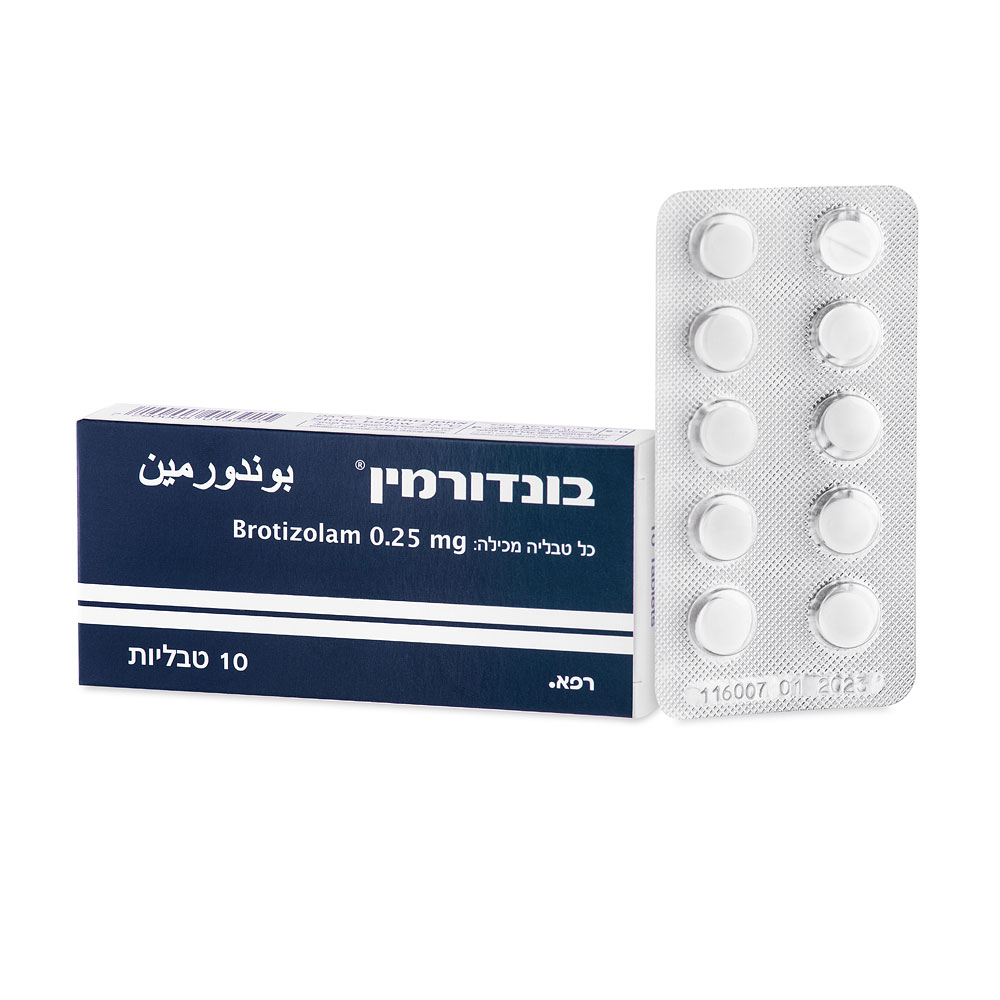Quest for the right Drug

בונדורמין BONDORMIN (BROTIZOLAM)
תרופה במרשם
תרופה בסל
נרקוטיקה
ציטוטוקסיקה
צורת מתן:
פומי : PER OS
צורת מינון:
טבליה : TABLETS
עלון לרופא
מינוניםPosology התוויות
Indications תופעות לוואי
Adverse reactions התוויות נגד
Contraindications אינטראקציות
Interactions מינון יתר
Overdose הריון/הנקה
Pregnancy & Lactation אוכלוסיות מיוחדות
Special populations תכונות פרמקולוגיות
Pharmacological properties מידע רוקחי
Pharmaceutical particulars אזהרת שימוש
Special Warning עלון לרופא
Physicians Leaflet
Posology : מינונים
4.2 Posology and method of administration Posology Unless otherwise prescribed, the usual dose is ½ - 1 tablet a day (equivalent to 0.125 - 0.25 mg brotizolam). Treatment should be started with ½ a tablet a day (equivalent to 0.125 mg brotizolam). Depending on individual response, ½ a tablet a day (equivalent to 0.125 mg brotizolam) may be sufficient. The maximum dose of 1 tablet a day (equivalent to 0.25 mg brotizolam) should not be exceeded because of the increased risk of adverse CNS effects. In isolated cases (e.g. pre-operative sleep disturbances) the dose may be increased to 2 tablets*. Special populations: A reduction in dosage to ½ a tablet a day should be considered in the following populations (see section 4.4): - patients with impaired liver function (see section 4.3 and section 5.2) - elderly and debilitated patients (see section 5.2) - patients with chronic respiratory insufficiency with hypercapnia due to the risk of respiratory depression, especially at night (see section 4.3) The tablets can be divided into equal halves for this purpose. No dosage adjustment is normally necessary in patients with impaired renal function (see 5.2). Paediatric population Bondormin is contraindicated in children aged up to 18 years (see section 4.3). Method of administration Bondormin should be taken with a little liquid just before going to bed. To avoid affecting the onset and duration of action, Bondormin should not be taken on a full stomach. Alternatively, the tablet may be allowed to dissolve under the tongue. Sufficient time for sleep must be guaranteed to reduce the risk of affecting reactions (and hence the ability to drive) the following morning. Patients should therefore ensure that they will be able to sleep for 7 - 8 hours after taking a tablet. Duration of treatment Treatment should be as short as possible. Generally, the duration of treatment varies from a few days to a maximum of two weeks. Treatment should be discontinued by gradual tapering, which should be tailored to the individual (see section 4.4). It should be borne in mind that discontinuation may initially cause rebound insomnia and that, in rare cases, restlessness, anxiety and tension may also occur. In certain cases, extension beyond the maximum two-week treatment period may be necessary; if so, it should not take place without re-evaluation of the patient's status.

שימוש לפי פנקס קופ''ח כללית 1994
Insomnia
תאריך הכללה מקורי בסל
01/01/1995
הגבלות
תרופה שאושרה לשימוש כללי בקופ'ח
מידע נוסף
